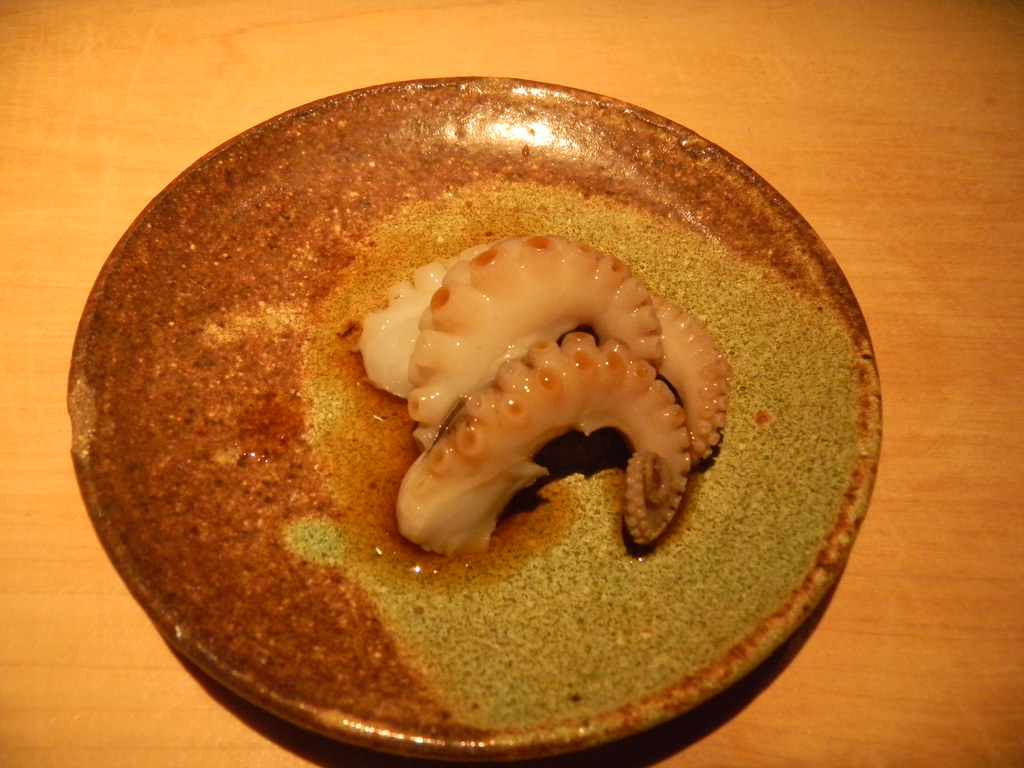
I was in Miami for Thanksgiving, listening to salsa music while eating turkey, which was great. Last Thanksgiving, I had a steak in Fort Lauderdale, but this year we had a very traditional Thanksgiving meal, with nontraditional music accompaniment. Since Thanksgiving Day's meal looks the same no matter how fancy, or tasty it may be, I will skip it.
I've been wanting to go to
NAOE restaurant for a while after I read about it on a blog a year ago or so. It's in Miami, but located far up on Collins Avenue, in an area called Sunny Isle. Even though I go to Miami about twice a year, and last time I was there in May, they were closed the entire time we were there. So when we decided to go to Miami for Thanksgiving Day, the first thing I did was to make a reservation there.
According to my information, chef Kevin Cory is Miami born, his mother's side of the family is from Ishikawa, Japan, and he went to train at his uncle's restaurant in Toyama prefecture for six months. Upon his return, he researched, studied more, and started the restaurant with his wife. How cute of a story is this? I heard the food is very unorthodox compared to regular Japanese restaurants, yet all the flavors are just top notch. I was very curious, and was very excited to try it.
We went there the day before Thanksgiving, and since they only had 6:30 and 9:30 slots, we left the hotel around 5:45 way in time for 6:30 reservation. What we didn't know was the traffic the day before Thanksgiving. The road was terribly packed with everyone going somewhere to eat turkey. I frantically called the restaurant, yet unfortunately no human picked up and their voice mail instructs you directions to the restaurant since they know they are located middle of nowhere. Finally we arrived close to 7pm, fearing we lost our reservation. Luckily everyone at the restaurant was very nice, and understanding.
Phew. We sat at the bar counter.
There's no menu, and basically you eat what chef serves you. This is pretty daring for Miami, since there aren't that many Japanese restaurants. Despite the fact the city hosts a reputable food festival every year, I think Miami is pretty weak when it comes to Japanese food. Sure, many restaurants are Japan-infused, like my
dining experience at Azul in May, but generally there aren't that many TRUE Japanese restaurant, as far as I've heard.
So we were in for the chef's
omakase for the evening.
From all the reviews, I knew they serve
kaiseki-style bento box as an appetizer, which includes rice. Appetizer, with rice? Really? Then the dinner is followed by a bunch of nigiri sushi. Very different from how we usually have course meals at Japanese restaurants in NYC, but almost refreshing.
Then came the bento box. Nice wooden box filled with goodies. Chef Kevin explained everything in detail.

Top left: the chef put raw hamachi (yellowtail) in the bowl with
yamaimo (mountain yam) and steamed it to perfection. Then, he added starch-thickened dashi on top, with ginko nuts from Japan, mitsuba stems (Japanese parsley), and a dab of fresh wasabi. The dashi was so delicate, very kaiseki-like flavor.
Top right:
shirako (they called it "cod milk", which was the least offensive way to describe it; but here at Umamimart we call it, "
fish jizz" which may be a bit too offensive for their customers) simmered in sake and soy sauce, sprinkled with
sansho (I think?). Left of the
shirako is
baigai, which is a small, conch-like clam (which seems to be a
specialty of Toyama, where Chef Cory's uncle works as a chef). It was well-flavored with sake. Next to the clam is smelt and yam tempura, and chestnut with
karasumi (bottarga).
Bottom left is shiitake rice. The amount of rice was just right, not too much, and it was a good portion as an appetizer.
Bottom right:
cobia sashimi. This was probably the only local fish they have, and it was very nice. Its flavor is a lighter version of yellowtail, but the texture is very chewy or what should I say, almost beef like. Very fresh, and what I like is how he cut shiso leaves into small pieces. Whenever you go to sushi restaurant, sushi or sashimi are served with a bit of daikon radish or shiso, but they are basically more for decoration. I think shiso really adds a great flavor, and sometimes, cuts the fishiness, yet no one eats them. So he had a bed of cut-up shiso underneath the cobia, which I thought was very smart--an untraditional way of serving it, which encouraged people to eat it. Of course all his wasabi is freshly grated.
We are now in for chef's progression for nigiri sushi. He had the most non-traditional technique for making nigiri sushi. He first made a tiny rice ball, placed it on the counter, added a bit of wasabi, then placed the fish on top. You know how regular sushi chef place rice on palm, adds wasabi and fish, then squeeze them just right? Nigiri comes from the word
nigiru, which means "to hold tight, or grab", but he wasn't grabbing his sushi whatsoever. Yet, he squeezed it at the end, just enough so that it doesn't fall apart. Brand new way of sushi making.
First was salmon belly. As I was chewing buttery salmon nigiri, I realized I forgot to take a picture. Here is an empty plate where salmon nigiri was.

Barely cooked lobster claw. He cooked the lobster in a very interesting and different ways--claws in one way, tails in another. Simply, since their thicknesses vary, they take different times to cook.

The claw was very soft, very sweet.
Iidako (octopus) from Portugal. Not chewy whatsoever, very sweet and very good texture. He poured orange-scented pouzu on top.

I skipped this, but Nate had kumamoto oyster from the west coast.

He added a bit of shiso, plus fresh wasabi. I really like how he incorporates shiso in dishes. Nate said it was very nice.
Fresh scallop. VERY sweet.
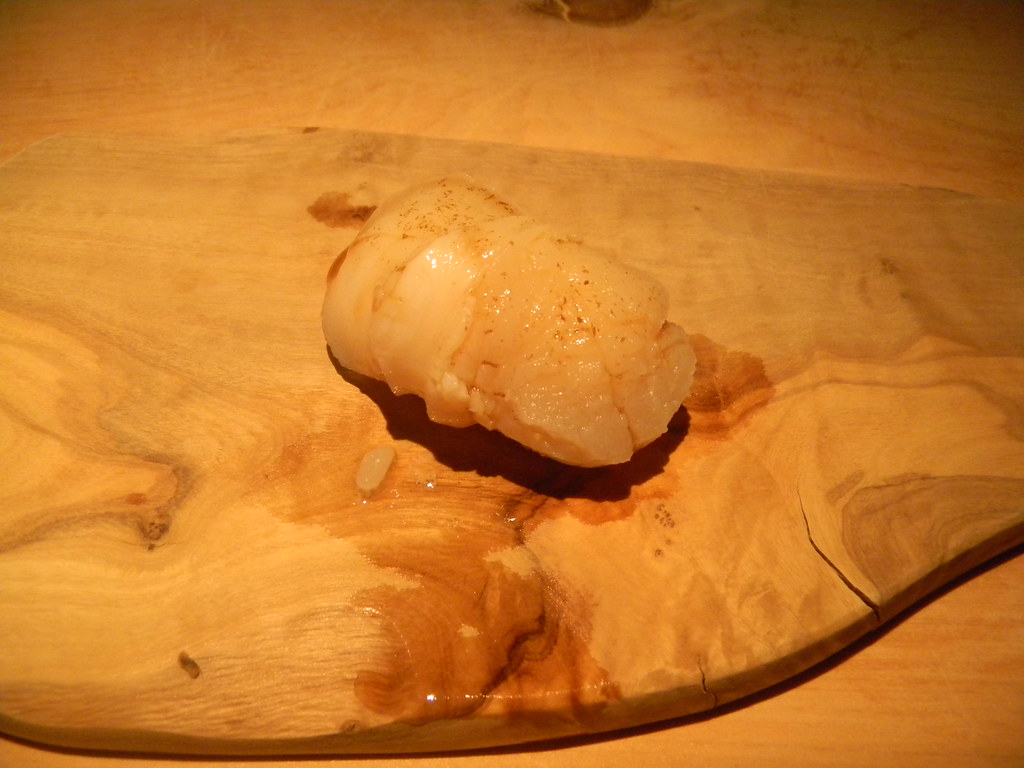
Oh, by the way, this is the kinda place where the chef dabs each sushi with home-blended soy sauce, or orange-scented ponzu. It turns out that the chef comes from a
shoyu-brewing family, in Kanazawa. No place for Kikkoman here.
Madai (sea bream). He kept the skin on, which is a traditional way of serving this sushi.
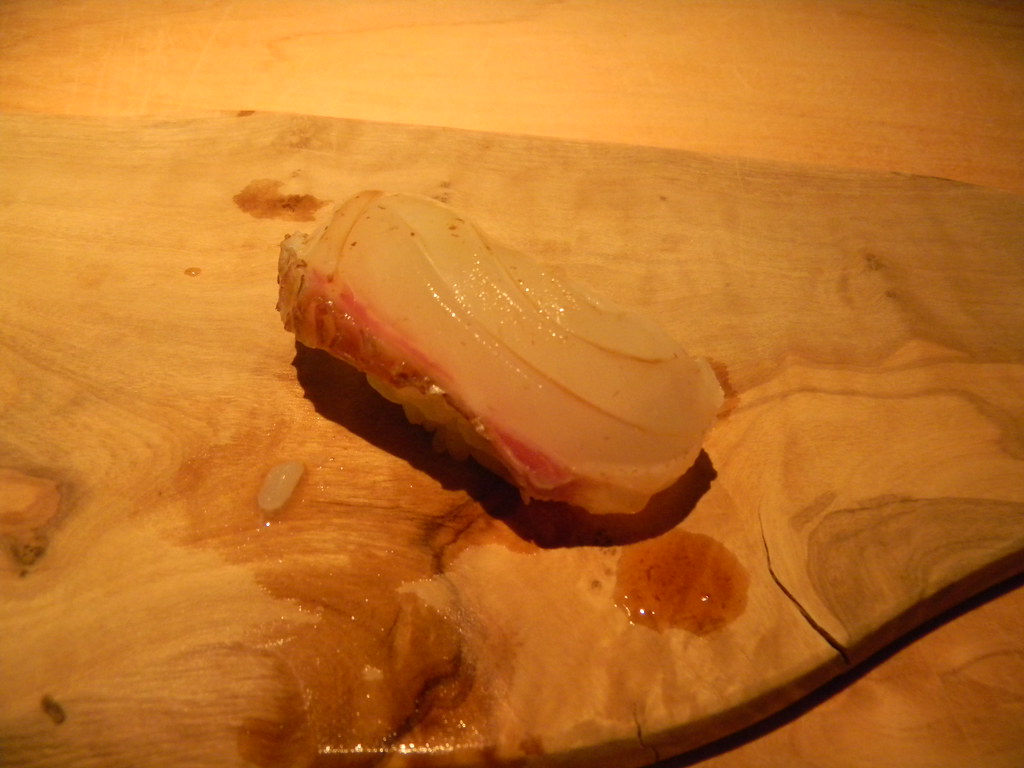
The skin added another level of texture. He really knows his fish.
Squid from Boston. He randomly slices it along the top, which was nice, and so sweet.
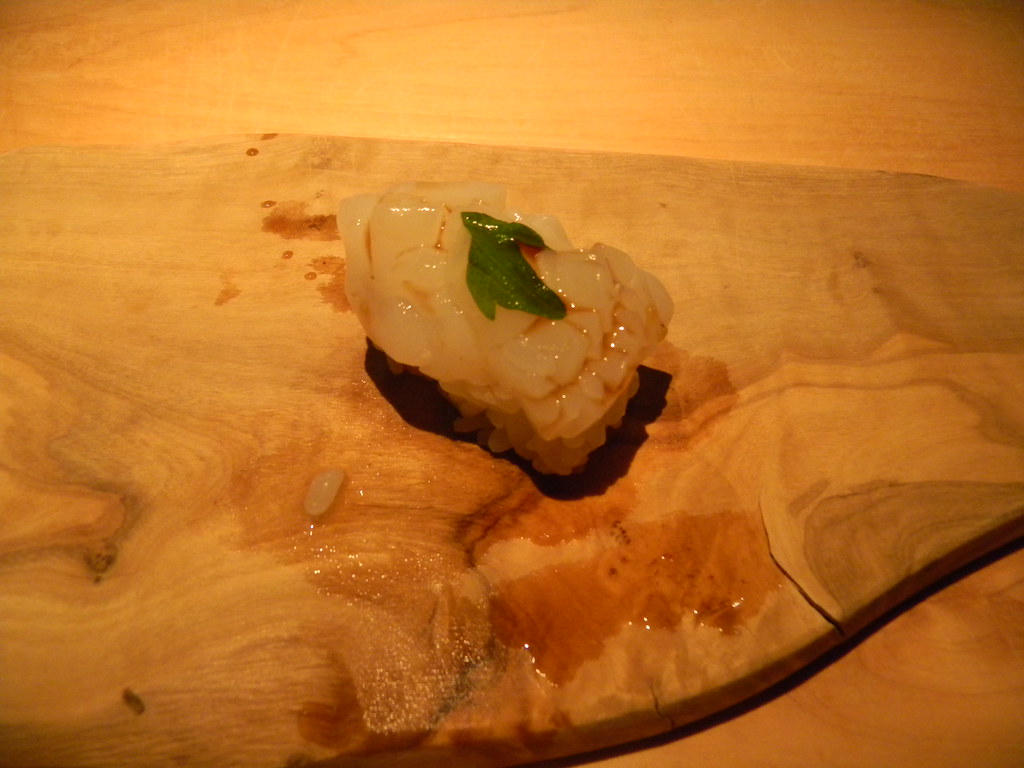 Aji
Aji (horse mackerel). Some of the freshest aji I've ever had. With grated ginger on top.
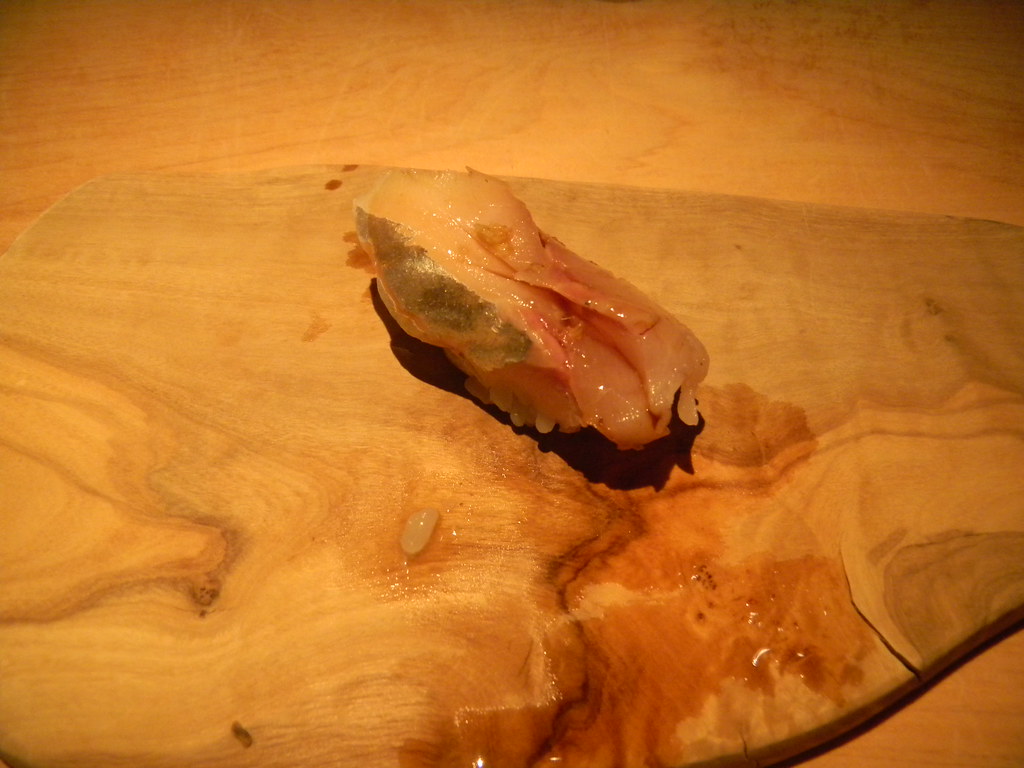
Cobia belly, with white seaweed on top. I am really digging this fish for its meat-like texture.
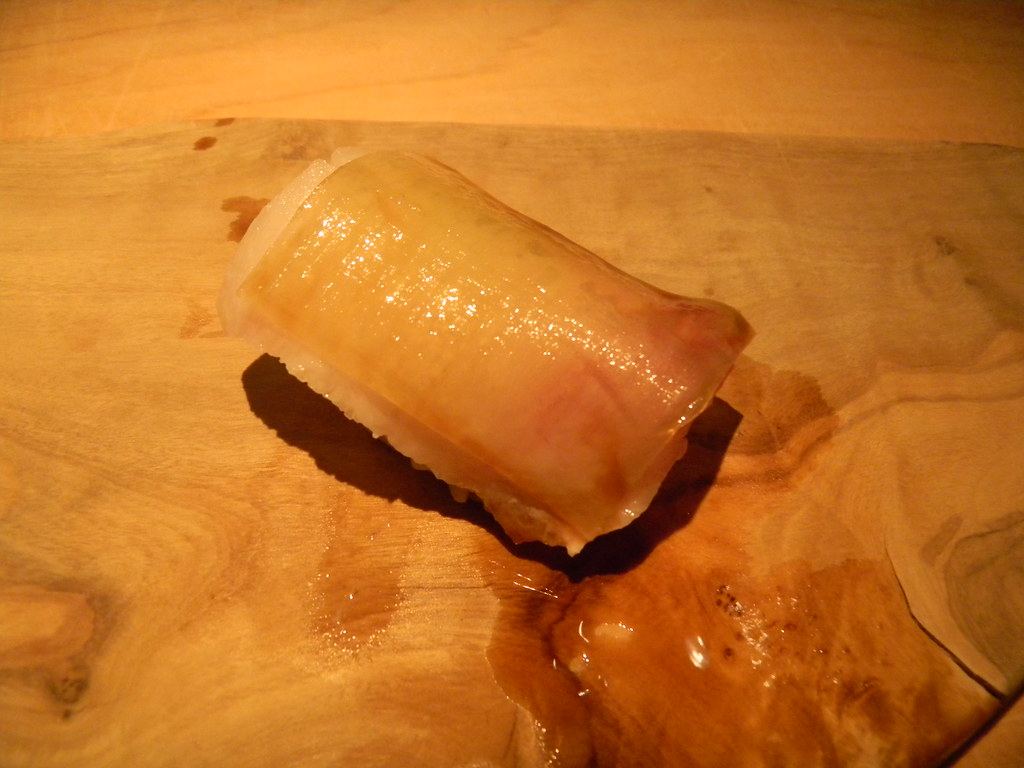
Uni!! Instead of wrapping it in nori, he placed a couple of pieces on top of the rice. Simple and true.
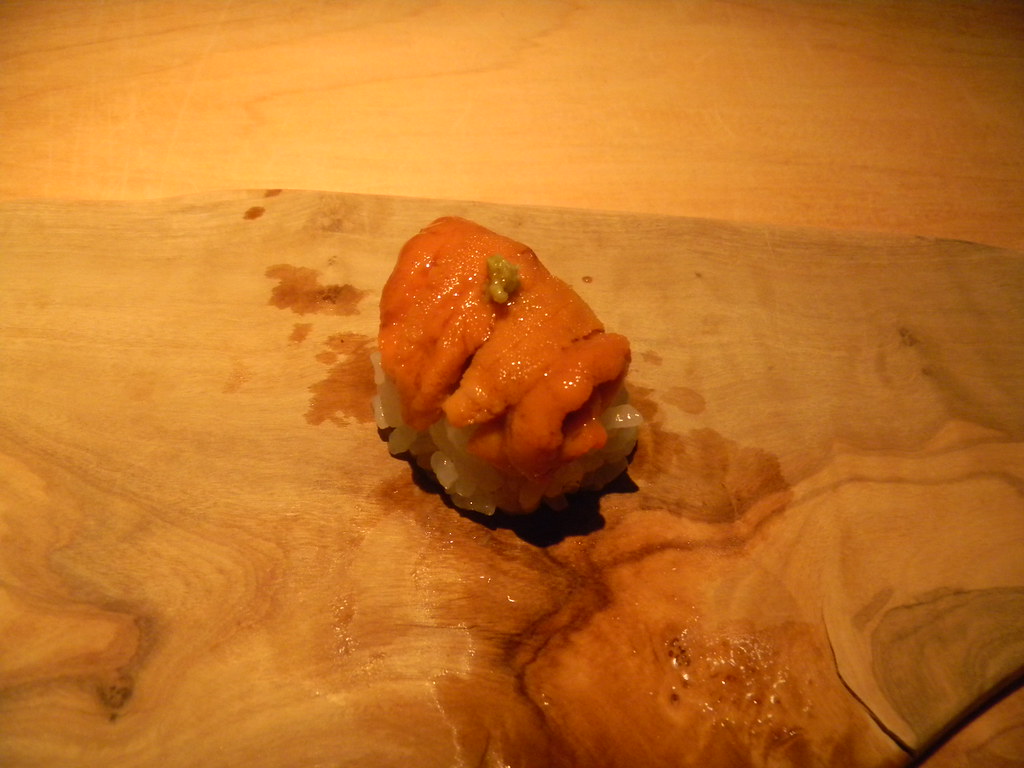
This uni was from Hokkaido. After tasting these babies, Santa Barbara uni is totally second class.
Here is his specialty. When he trained in Toyama at his uncle's restaurant, the place featured unagi (freshwater eel), where he learned to cut up the live eel, debone them, and steam them to perfection (like in
Kayoko's post the other week).

These fresh (not in the pack, from China) eels are extremely different from what you may think of as unagi. So soft, so clean, with no weird chemical flavor we usually taste in the pre-packed kinds. Brilliant. This was steamed, with sea salt sprinkled on top--no sauce.
Last but not at least, eel kabayaki. As we were eating and chatting about food, he kept going back to oven, dabbing kabayaki sauce on the eel, and after like 15 minutes of nicely grilling, he gave the last awesome piece of eel sushi.
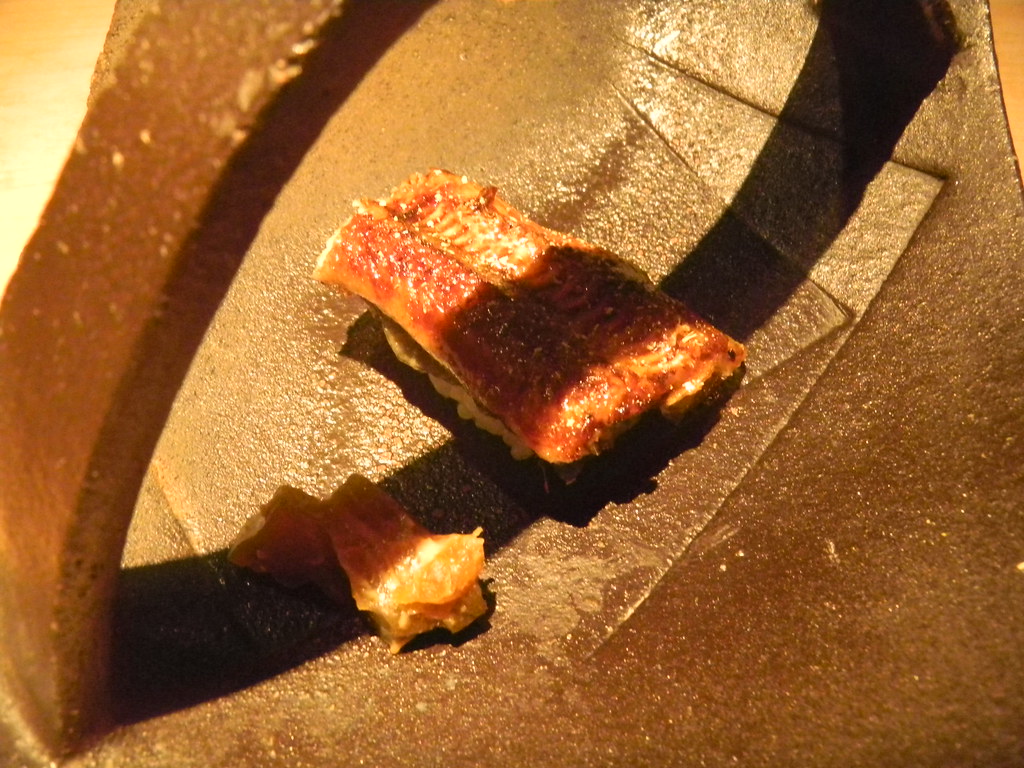
Oh, on the left side, you see pickles, which is
narazuke, one of my favorite pickles. Japanese melon (cucumber-like gourd) is pickled in
sakekasu (sake lees). This is special since it's been sitting in it for 2 years. Wow, so flavorful, almost boozy.
This was very good. I still don't know if Miami diners are daring enough to keep up with chef Kevin's style, but to us, it was so good. He said 80% of his customers are from NYC, no wonder. They have 16 seats, and when we got there, it was half full. I was like, "I thought it was so hard to make reservation here", and he said, he only takes eight guests per seating. What a luxury. How the hell does he make money??!!
And I found out some great news from the chef. Due to the fact the landlord is bulldozing the current location, they are MOVING TO MIAMI PROPER! No longer do Miamians need to drive for 30 minutes! They will operate at the current location until the end of December, and they will reopen in Brickell, across from Mandarin Oriental Hotel (where we usually stay), sometime in February or March. I can't wait for the next visit at the new location.
What I also found out was, Naoe is Kevin's mom's maiden name. He figured Kevin as Japanese restaurant name wouldn't make any sense.
If you aren't afraid of trying Japanese seafood little-known in the States, this is the place in Miami.
 I was in Miami for Thanksgiving, listening to salsa music while eating turkey, which was great. Last Thanksgiving, I had a steak in Fort Lauderdale, but this year we had a very traditional Thanksgiving meal, with nontraditional music accompaniment. Since Thanksgiving Day's meal looks the same no matter how fancy, or tasty it may be, I will skip it.
I've been wanting to go to NAOE restaurant for a while after I read about it on a blog a year ago or so. It's in Miami, but located far up on Collins Avenue, in an area called Sunny Isle. Even though I go to Miami about twice a year, and last time I was there in May, they were closed the entire time we were there. So when we decided to go to Miami for Thanksgiving Day, the first thing I did was to make a reservation there.
According to my information, chef Kevin Cory is Miami born, his mother's side of the family is from Ishikawa, Japan, and he went to train at his uncle's restaurant in Toyama prefecture for six months. Upon his return, he researched, studied more, and started the restaurant with his wife. How cute of a story is this? I heard the food is very unorthodox compared to regular Japanese restaurants, yet all the flavors are just top notch. I was very curious, and was very excited to try it.
We went there the day before Thanksgiving, and since they only had 6:30 and 9:30 slots, we left the hotel around 5:45 way in time for 6:30 reservation. What we didn't know was the traffic the day before Thanksgiving. The road was terribly packed with everyone going somewhere to eat turkey. I frantically called the restaurant, yet unfortunately no human picked up and their voice mail instructs you directions to the restaurant since they know they are located middle of nowhere. Finally we arrived close to 7pm, fearing we lost our reservation. Luckily everyone at the restaurant was very nice, and understanding.
Phew. We sat at the bar counter.
There's no menu, and basically you eat what chef serves you. This is pretty daring for Miami, since there aren't that many Japanese restaurants. Despite the fact the city hosts a reputable food festival every year, I think Miami is pretty weak when it comes to Japanese food. Sure, many restaurants are Japan-infused, like my dining experience at Azul in May, but generally there aren't that many TRUE Japanese restaurant, as far as I've heard.
So we were in for the chef's omakase for the evening.
From all the reviews, I knew they serve kaiseki-style bento box as an appetizer, which includes rice. Appetizer, with rice? Really? Then the dinner is followed by a bunch of nigiri sushi. Very different from how we usually have course meals at Japanese restaurants in NYC, but almost refreshing.
Then came the bento box. Nice wooden box filled with goodies. Chef Kevin explained everything in detail.
I was in Miami for Thanksgiving, listening to salsa music while eating turkey, which was great. Last Thanksgiving, I had a steak in Fort Lauderdale, but this year we had a very traditional Thanksgiving meal, with nontraditional music accompaniment. Since Thanksgiving Day's meal looks the same no matter how fancy, or tasty it may be, I will skip it.
I've been wanting to go to NAOE restaurant for a while after I read about it on a blog a year ago or so. It's in Miami, but located far up on Collins Avenue, in an area called Sunny Isle. Even though I go to Miami about twice a year, and last time I was there in May, they were closed the entire time we were there. So when we decided to go to Miami for Thanksgiving Day, the first thing I did was to make a reservation there.
According to my information, chef Kevin Cory is Miami born, his mother's side of the family is from Ishikawa, Japan, and he went to train at his uncle's restaurant in Toyama prefecture for six months. Upon his return, he researched, studied more, and started the restaurant with his wife. How cute of a story is this? I heard the food is very unorthodox compared to regular Japanese restaurants, yet all the flavors are just top notch. I was very curious, and was very excited to try it.
We went there the day before Thanksgiving, and since they only had 6:30 and 9:30 slots, we left the hotel around 5:45 way in time for 6:30 reservation. What we didn't know was the traffic the day before Thanksgiving. The road was terribly packed with everyone going somewhere to eat turkey. I frantically called the restaurant, yet unfortunately no human picked up and their voice mail instructs you directions to the restaurant since they know they are located middle of nowhere. Finally we arrived close to 7pm, fearing we lost our reservation. Luckily everyone at the restaurant was very nice, and understanding.
Phew. We sat at the bar counter.
There's no menu, and basically you eat what chef serves you. This is pretty daring for Miami, since there aren't that many Japanese restaurants. Despite the fact the city hosts a reputable food festival every year, I think Miami is pretty weak when it comes to Japanese food. Sure, many restaurants are Japan-infused, like my dining experience at Azul in May, but generally there aren't that many TRUE Japanese restaurant, as far as I've heard.
So we were in for the chef's omakase for the evening.
From all the reviews, I knew they serve kaiseki-style bento box as an appetizer, which includes rice. Appetizer, with rice? Really? Then the dinner is followed by a bunch of nigiri sushi. Very different from how we usually have course meals at Japanese restaurants in NYC, but almost refreshing.
Then came the bento box. Nice wooden box filled with goodies. Chef Kevin explained everything in detail.
 Top left: the chef put raw hamachi (yellowtail) in the bowl with yamaimo (mountain yam) and steamed it to perfection. Then, he added starch-thickened dashi on top, with ginko nuts from Japan, mitsuba stems (Japanese parsley), and a dab of fresh wasabi. The dashi was so delicate, very kaiseki-like flavor.
Top right: shirako (they called it "cod milk", which was the least offensive way to describe it; but here at Umamimart we call it, "fish jizz" which may be a bit too offensive for their customers) simmered in sake and soy sauce, sprinkled with sansho (I think?). Left of the shirako is baigai, which is a small, conch-like clam (which seems to be a specialty of Toyama, where Chef Cory's uncle works as a chef). It was well-flavored with sake. Next to the clam is smelt and yam tempura, and chestnut with karasumi (bottarga).
Bottom left is shiitake rice. The amount of rice was just right, not too much, and it was a good portion as an appetizer.
Bottom right: cobia sashimi. This was probably the only local fish they have, and it was very nice. Its flavor is a lighter version of yellowtail, but the texture is very chewy or what should I say, almost beef like. Very fresh, and what I like is how he cut shiso leaves into small pieces. Whenever you go to sushi restaurant, sushi or sashimi are served with a bit of daikon radish or shiso, but they are basically more for decoration. I think shiso really adds a great flavor, and sometimes, cuts the fishiness, yet no one eats them. So he had a bed of cut-up shiso underneath the cobia, which I thought was very smart--an untraditional way of serving it, which encouraged people to eat it. Of course all his wasabi is freshly grated.
We are now in for chef's progression for nigiri sushi. He had the most non-traditional technique for making nigiri sushi. He first made a tiny rice ball, placed it on the counter, added a bit of wasabi, then placed the fish on top. You know how regular sushi chef place rice on palm, adds wasabi and fish, then squeeze them just right? Nigiri comes from the word nigiru, which means "to hold tight, or grab", but he wasn't grabbing his sushi whatsoever. Yet, he squeezed it at the end, just enough so that it doesn't fall apart. Brand new way of sushi making.
First was salmon belly. As I was chewing buttery salmon nigiri, I realized I forgot to take a picture. Here is an empty plate where salmon nigiri was.
Top left: the chef put raw hamachi (yellowtail) in the bowl with yamaimo (mountain yam) and steamed it to perfection. Then, he added starch-thickened dashi on top, with ginko nuts from Japan, mitsuba stems (Japanese parsley), and a dab of fresh wasabi. The dashi was so delicate, very kaiseki-like flavor.
Top right: shirako (they called it "cod milk", which was the least offensive way to describe it; but here at Umamimart we call it, "fish jizz" which may be a bit too offensive for their customers) simmered in sake and soy sauce, sprinkled with sansho (I think?). Left of the shirako is baigai, which is a small, conch-like clam (which seems to be a specialty of Toyama, where Chef Cory's uncle works as a chef). It was well-flavored with sake. Next to the clam is smelt and yam tempura, and chestnut with karasumi (bottarga).
Bottom left is shiitake rice. The amount of rice was just right, not too much, and it was a good portion as an appetizer.
Bottom right: cobia sashimi. This was probably the only local fish they have, and it was very nice. Its flavor is a lighter version of yellowtail, but the texture is very chewy or what should I say, almost beef like. Very fresh, and what I like is how he cut shiso leaves into small pieces. Whenever you go to sushi restaurant, sushi or sashimi are served with a bit of daikon radish or shiso, but they are basically more for decoration. I think shiso really adds a great flavor, and sometimes, cuts the fishiness, yet no one eats them. So he had a bed of cut-up shiso underneath the cobia, which I thought was very smart--an untraditional way of serving it, which encouraged people to eat it. Of course all his wasabi is freshly grated.
We are now in for chef's progression for nigiri sushi. He had the most non-traditional technique for making nigiri sushi. He first made a tiny rice ball, placed it on the counter, added a bit of wasabi, then placed the fish on top. You know how regular sushi chef place rice on palm, adds wasabi and fish, then squeeze them just right? Nigiri comes from the word nigiru, which means "to hold tight, or grab", but he wasn't grabbing his sushi whatsoever. Yet, he squeezed it at the end, just enough so that it doesn't fall apart. Brand new way of sushi making.
First was salmon belly. As I was chewing buttery salmon nigiri, I realized I forgot to take a picture. Here is an empty plate where salmon nigiri was.
 Barely cooked lobster claw. He cooked the lobster in a very interesting and different ways--claws in one way, tails in another. Simply, since their thicknesses vary, they take different times to cook.
Barely cooked lobster claw. He cooked the lobster in a very interesting and different ways--claws in one way, tails in another. Simply, since their thicknesses vary, they take different times to cook.
 The claw was very soft, very sweet.
Iidako (octopus) from Portugal. Not chewy whatsoever, very sweet and very good texture. He poured orange-scented pouzu on top.
The claw was very soft, very sweet.
Iidako (octopus) from Portugal. Not chewy whatsoever, very sweet and very good texture. He poured orange-scented pouzu on top.
 I skipped this, but Nate had kumamoto oyster from the west coast.
I skipped this, but Nate had kumamoto oyster from the west coast.
 He added a bit of shiso, plus fresh wasabi. I really like how he incorporates shiso in dishes. Nate said it was very nice.
Fresh scallop. VERY sweet.
He added a bit of shiso, plus fresh wasabi. I really like how he incorporates shiso in dishes. Nate said it was very nice.
Fresh scallop. VERY sweet.
 Oh, by the way, this is the kinda place where the chef dabs each sushi with home-blended soy sauce, or orange-scented ponzu. It turns out that the chef comes from a shoyu-brewing family, in Kanazawa. No place for Kikkoman here.
Madai (sea bream). He kept the skin on, which is a traditional way of serving this sushi.
Oh, by the way, this is the kinda place where the chef dabs each sushi with home-blended soy sauce, or orange-scented ponzu. It turns out that the chef comes from a shoyu-brewing family, in Kanazawa. No place for Kikkoman here.
Madai (sea bream). He kept the skin on, which is a traditional way of serving this sushi.
 The skin added another level of texture. He really knows his fish.
Squid from Boston. He randomly slices it along the top, which was nice, and so sweet.
The skin added another level of texture. He really knows his fish.
Squid from Boston. He randomly slices it along the top, which was nice, and so sweet.
 Aji (horse mackerel). Some of the freshest aji I've ever had. With grated ginger on top.
Aji (horse mackerel). Some of the freshest aji I've ever had. With grated ginger on top.
 Cobia belly, with white seaweed on top. I am really digging this fish for its meat-like texture.
Cobia belly, with white seaweed on top. I am really digging this fish for its meat-like texture.
 Uni!! Instead of wrapping it in nori, he placed a couple of pieces on top of the rice. Simple and true.
Uni!! Instead of wrapping it in nori, he placed a couple of pieces on top of the rice. Simple and true.
 This uni was from Hokkaido. After tasting these babies, Santa Barbara uni is totally second class.
Here is his specialty. When he trained in Toyama at his uncle's restaurant, the place featured unagi (freshwater eel), where he learned to cut up the live eel, debone them, and steam them to perfection (like in Kayoko's post the other week).
This uni was from Hokkaido. After tasting these babies, Santa Barbara uni is totally second class.
Here is his specialty. When he trained in Toyama at his uncle's restaurant, the place featured unagi (freshwater eel), where he learned to cut up the live eel, debone them, and steam them to perfection (like in Kayoko's post the other week).
 These fresh (not in the pack, from China) eels are extremely different from what you may think of as unagi. So soft, so clean, with no weird chemical flavor we usually taste in the pre-packed kinds. Brilliant. This was steamed, with sea salt sprinkled on top--no sauce.
Last but not at least, eel kabayaki. As we were eating and chatting about food, he kept going back to oven, dabbing kabayaki sauce on the eel, and after like 15 minutes of nicely grilling, he gave the last awesome piece of eel sushi.
These fresh (not in the pack, from China) eels are extremely different from what you may think of as unagi. So soft, so clean, with no weird chemical flavor we usually taste in the pre-packed kinds. Brilliant. This was steamed, with sea salt sprinkled on top--no sauce.
Last but not at least, eel kabayaki. As we were eating and chatting about food, he kept going back to oven, dabbing kabayaki sauce on the eel, and after like 15 minutes of nicely grilling, he gave the last awesome piece of eel sushi.
 Oh, on the left side, you see pickles, which is narazuke, one of my favorite pickles. Japanese melon (cucumber-like gourd) is pickled in sakekasu (sake lees). This is special since it's been sitting in it for 2 years. Wow, so flavorful, almost boozy.
This was very good. I still don't know if Miami diners are daring enough to keep up with chef Kevin's style, but to us, it was so good. He said 80% of his customers are from NYC, no wonder. They have 16 seats, and when we got there, it was half full. I was like, "I thought it was so hard to make reservation here", and he said, he only takes eight guests per seating. What a luxury. How the hell does he make money??!!
And I found out some great news from the chef. Due to the fact the landlord is bulldozing the current location, they are MOVING TO MIAMI PROPER! No longer do Miamians need to drive for 30 minutes! They will operate at the current location until the end of December, and they will reopen in Brickell, across from Mandarin Oriental Hotel (where we usually stay), sometime in February or March. I can't wait for the next visit at the new location.
What I also found out was, Naoe is Kevin's mom's maiden name. He figured Kevin as Japanese restaurant name wouldn't make any sense.
If you aren't afraid of trying Japanese seafood little-known in the States, this is the place in Miami.
Oh, on the left side, you see pickles, which is narazuke, one of my favorite pickles. Japanese melon (cucumber-like gourd) is pickled in sakekasu (sake lees). This is special since it's been sitting in it for 2 years. Wow, so flavorful, almost boozy.
This was very good. I still don't know if Miami diners are daring enough to keep up with chef Kevin's style, but to us, it was so good. He said 80% of his customers are from NYC, no wonder. They have 16 seats, and when we got there, it was half full. I was like, "I thought it was so hard to make reservation here", and he said, he only takes eight guests per seating. What a luxury. How the hell does he make money??!!
And I found out some great news from the chef. Due to the fact the landlord is bulldozing the current location, they are MOVING TO MIAMI PROPER! No longer do Miamians need to drive for 30 minutes! They will operate at the current location until the end of December, and they will reopen in Brickell, across from Mandarin Oriental Hotel (where we usually stay), sometime in February or March. I can't wait for the next visit at the new location.
What I also found out was, Naoe is Kevin's mom's maiden name. He figured Kevin as Japanese restaurant name wouldn't make any sense.
If you aren't afraid of trying Japanese seafood little-known in the States, this is the place in Miami.




Comments (4)
Thinking we should brand “Yamahomo Milk”. Any takers???
[Sorry for the late comment but I thought of this during work tonight and couldn’t help but lol].
How gross! Think about “Kayoko milk”, where it may come from.
I think it is genius. A magical potion to make everyone cook and sew and knit like Yamahomo! YamaPower!
Even grosser..